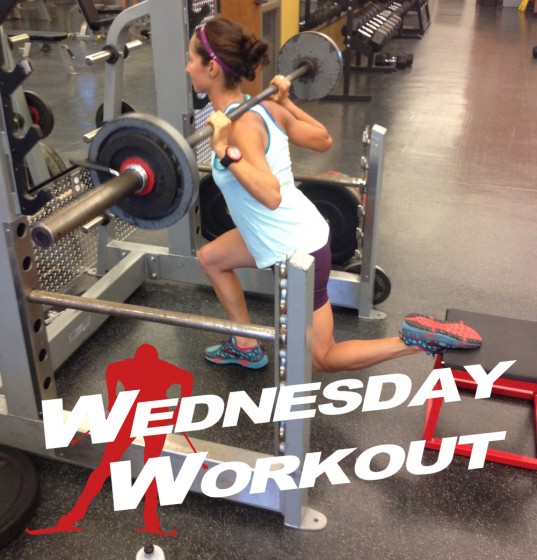
This week’s workout comes from Chelsea Holmes, who recently joined the Alaska Pacific University (APU) Elite Nordic Team after three seasons with the Sun Valley Ski Education Foundation in Sun Valley, Idaho. Originally from Girdwood, Alaska, Holmes, 27, returned to her hometown glacier earlier this summer as one of 14 of women with the North American Women’s Training Alliance — a U.S. Ski Team camp held annually in Anchorage and on Eagle Glacier. Below she gives a detailed explanation of what she does to build strength and work on her weaknesses.
***
My Strengths (and many weaknesses)!
Strength training should be an important staple in every endurance athlete’s regimen. It is important to note that the weight, duration, number of repetitions and sets are all individual and should be catered around the individual’s experience, age, and training plan. The quality of technique should be priority, and only when comfortable and confident in an exercise should an individual attempt maximal exercises. Additionally it is recommended to have a partner to spot and assist in these exercises.
My strength sessions often address numerous muscle groups and modes of training and development within a single session. This is due to the irregular and intense nature of cross-country ski training and the time constraints in a week.

My current routine includes:
– Focus: Maximal-strength exercises where the load is high and the repetitions are low.
– Quickness (often incorporated into my warmup): I like to spend some time during the workout doing either drills on a speed ladder (shown above) or jump rope. When jump roping, focus on speed and the power coming from your calves. Try 30 on both legs before moving to 15 per single leg.
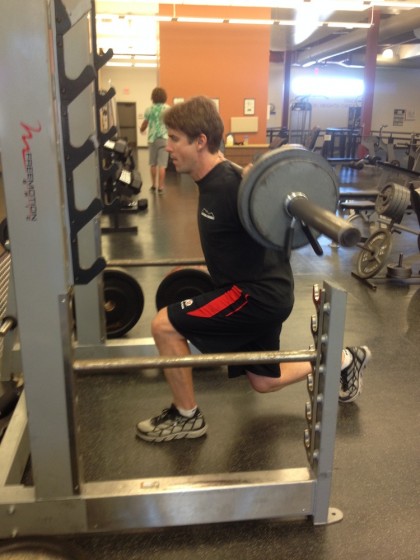
What: Single-Leg Squats
Position: In a standard-squat rack, put a reasonable weight on the squat bar. Lift the weight and once set and balanced, place one foot back behind you on a low stand with your foot perpendicular to the floor (useful tools: plyo boxes, stools), or, as shown at right, just place your back leg on the floor with your toe facing down. While keeping your front knee inline over your toe (no twisting or caving medially) perform a squat motion. Switch sides!
The front leg should be the source of power, felt in the quadriceps, hamstring and gluteus. The back leg is there only for stability and balance. This should be felt in the quadriceps, hamstring, and gluteus. If you feel the need to use your back leg when powering up, go down in weight. Do not bend forward at the waist, or try to lift with your back. Your core acts as a stabilizer here.
Why: I have been using single-leg exercise because in the past I have noticed a personal tendency to favor a leg and compensate. I also use the single-leg squat as it should stimulate the intrinsic muscles as there is a balance component to the exercise. Maximal exercises develop the time to peak force, efficiency and maximal power.
Note: After comfort and proficiency have been developed, try to superset this exercise. I will sometimes perform a set of 6-8 jumps (high jumps onto a plyo box, tuck jumps or skate jumps) directly after each set.
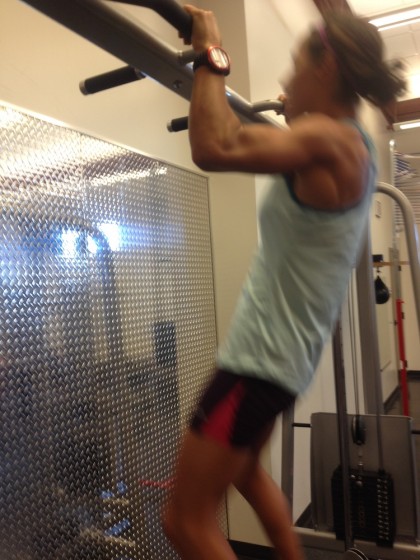
What: Pull-Ups
Position: A standard pull-up (shown above). The important cues to note in this exercise are full range of motion, a wide enough hand position that you are engaging your latissimus fully and minimal swing. I most often use an overhand grip.
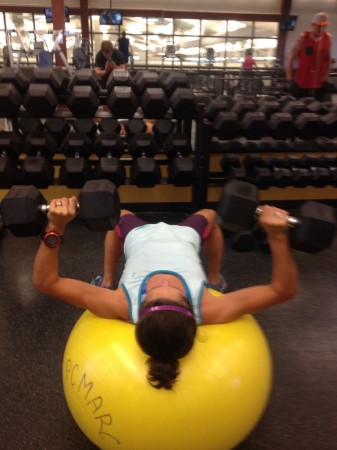
What: Dumbbell Press on Swiss Ball
This is a simple a bench press (shown above), only using dumbbells and instead of laying on a bench you are supported by laying with your upper back centered on a Swiss ball and feet planted in a stable position. From a sitting position on the Swiss ball, roll yourself forward on the ball so that the ball is centered underneath your upper back with your feet planted firmly and your core held in a plank position (of course, chest face up here!), perform a standard press.
Why: There is so much focus on posterior exercises in skiing that it is important to ensure a balanced body. I like the addition of a swiss ball because it adds a component of balance and core.
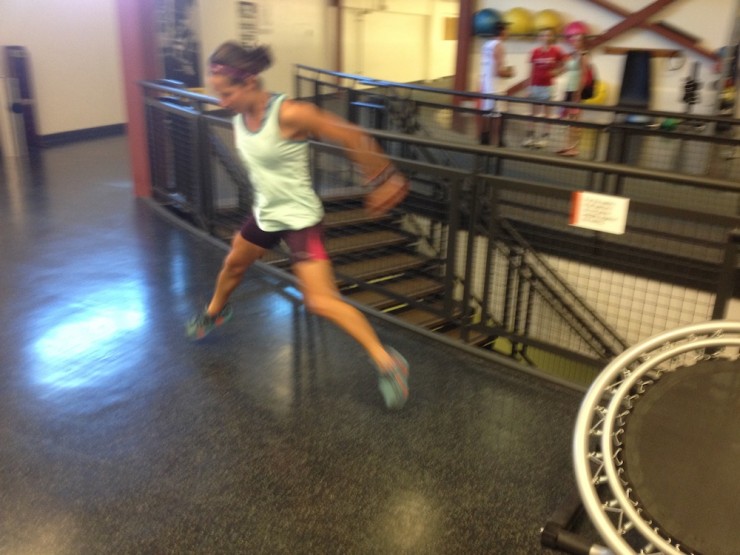
What: Skate Jumps (above) — a lateral jump focused on developing quickness, power and stability. Do this exercise in front of a mirror to help focus on technique.
Position: While standing on a single leg sink into the leg before exploding up and over lateral to the opposing leg. Through the landing on the opposite leg, try to control the forces and stay balanced. Through the landing phase, you should end up in the starting position for the next jump. The jump should come from the forefoot. Use your upper body mimic a powerful skating motion.
What: Balance
1. Single-leg squats on a Bosu ball or instability disk. (If using an instability disk, you might have to place the disk on a small box to allow for the range of motion through the squat.)
In front of a mirror, stand one footed on a Bosu ball with the platform down. Place the foot, toe slightly turned out, with the ball of the foot being placed on top and in the center of the dome or disk. Balancing on that foot, slowly perform a squat to a comfortable and stable depth. A broom handle held across the shoulders parallel to the floor can be a useful tool to ensure no twisting or leaning. The focus is balance, so really focus on minimal teetering and extraneous movement. When first beginning these, simply spend a few sessions doing half squats or just practice standing on one leg.
These are not only great for balance but also the many stabilizer muscles that are extremely important but easy to forget about. This exercise is great to practice breathing and total focus — it’s easy to get distracted in a busy gym! I prefer to do these in the second half of my workout when my body and mind begin to tire — mind over matter!
It’s easy to get distracted in a busy gym! I prefer to do [single-leg squats] in the second half of my workout when my body and mind begin to tire — mind over matter!
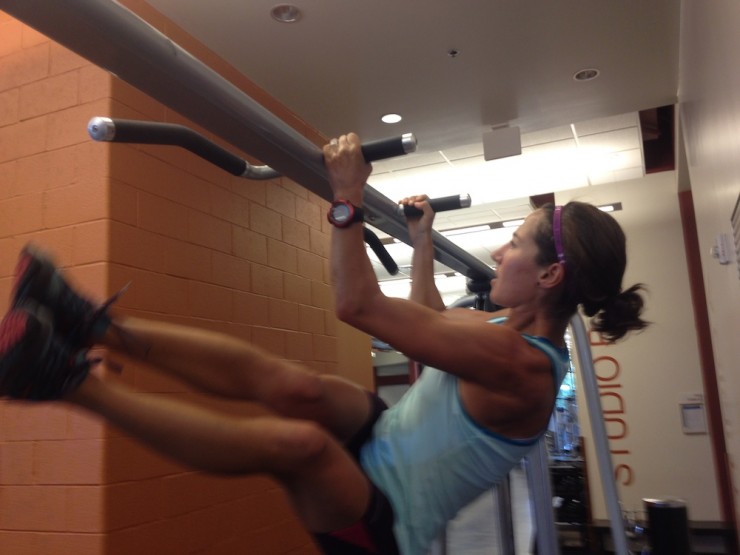
What: Core
1. Pikes — Either a TRX or a Swiss ball can be used in this situation.
Position: Place yourself in a plank position with your feet either in the TRX stirrup (toes down) or if using a Swiss ball, place the top of your foot on the ball. Your hands should be planted beneath your shoulders, palms against the ground and arms straight, similar to a push up position.
Exercise: Bring your body into a pike position with as little arm and knee bend possible, return to plank, now bring your knees underneath your body, driving the opposing knee to opposing elbow. The knees should bend together and twist so that you feel a rotational core component. To get the most out of this exercise, don’t rush it! Perform it in a controlled manner and with purpose.
Why: I really like this exercise because it is full body, and no matter how many times I do it, it is always a challenge. It has an isometric, concentric and eccentric component. Bang for your buck!
2. Garhammers (video demo)
Position: Hang from a pull-up bar with straight legs. Start by bringing you knees up so that your quadriceps are parallel to the ground, this is where the exercise starts and finishes for each repetition. Then drive your knees upwards by rotating your pelvis forward and focusing on your core making that movement.
Please note, there is not a tremendous range of motion with this exercise. If you feel you are ready for a more advanced version of this exercise, after driving your knees up, straighten your lower legs and lower your legs slowly back to parallel.
3. Alternating Push-Ups
I truly despise pushups so I think I gravitated to this style because it is much harder for me than standard push-ups and as such I cannot do as many. This is not a cop out, these are tough.
Position: From a standard pushup position, move your right hand back along your body so it is planted below the bottom of your rib cage (it is placed next to your body, not away from it), while leaving your left hand up slightly away from the shoulder. When you lower yourself into a pushup your upper right arm should track back parallel against your body so that it targets not only the front deltoid but your triceps as well. Your left arm will track as it usually does in a standard push-up. Start with 5 per side before switching. If you feel your core begin to sag, move to your knees- I always end my sets worn out and doing the last push ups from my knees.




3 comments
xcq
August 20, 2014 at 4:28 pm
Noah Hoffman is the only US athlete that has the balls to blow off USST training to travel to NZ for a glacier camp (thanks Justyna Kowalczyk for the validation) – FS fails to cover that; Chelsea Little writes an entire article about RAE while “understanding” the concept literally backwards;l and now Chelsea Holmes gets to write an article about Chelsea Holmes’ training. This coverage is so epic.
sully2
August 20, 2014 at 6:44 pm
No need for FS to cover it, as Noah’s blog does it beautifully. Pretty much, “Great snow, skied 5 hours today, check out these cool pictures….” Kid is an animal, and I appreciate his willingness to share as much and as often as he does. He and the 2 sprint guys from Stratton are keeping U.S. Men’s Nordic relevant, which historically has been hard to do. Fantastic stuff!
How could you have a problem with the Chelsea Holmes training piece? Super easy to follow, and a very solid strength plan. And very nice of her to take the time to share it. Young (and not-so-young) nordic skiers around the country can check that out and use it as is, or modify it to fit their needs.
campirecord
August 25, 2014 at 9:22 pm
Someone refund the person, whatever he/she said from the bleachers of contempt…